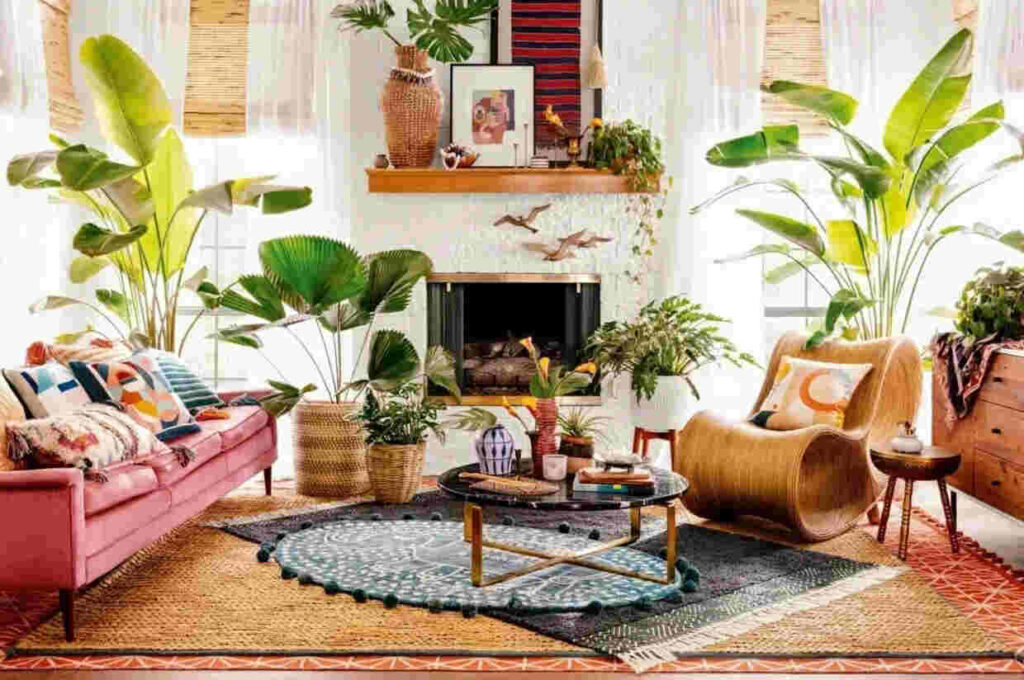Bohemian, or “boho,” living room decor is all about embracing individuality, creativity, and a relaxed atmosphere. This eclectic style combines different colors, textures, and patterns to create a warm and inviting space. In this guide, we’ll explore the key elements of a boho living room, provide tips on how to achieve this look, and offer a table of essential components. We’ll also include and explain relevant LSI (Latent Semantic Indexing) keywords to enhance your understanding and application of this style.
Key Characteristics of Boho Living Room Design
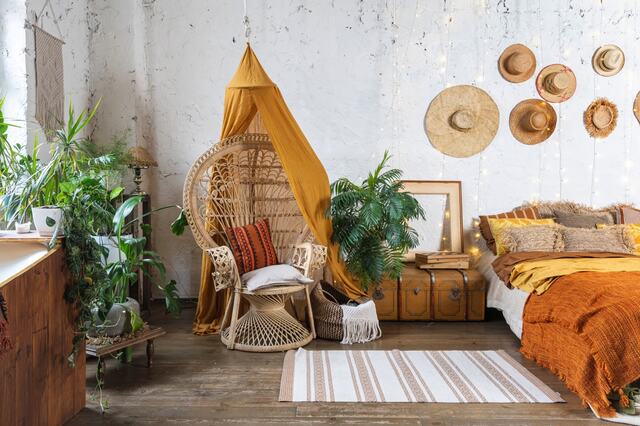
Eclectic Mix
A boho living room is defined by its eclectic mix of furniture, textiles, and accessories. This style does not adhere to a single design rule but rather celebrates a harmonious blend of different cultures, eras, and influences. You might find a vintage armchair paired with a modern coffee table, or a traditional Persian rug alongside contemporary artwork. The key is to create a space that feels personal and curated, rather than one that follows a strict design formula. This eclectic approach allows for a high level of creativity and individuality, making each boho living room unique.
Vibrant Colors and Patterns
Bohemian decor is known for its use of vibrant colors and bold patterns. Unlike minimalist styles that rely on a neutral palette, boho design embraces a wide spectrum of hues, from deep jewel tones to bright, cheerful shades. Patterns play a significant role, with floral, tribal, and geometric prints commonly featured in rugs, cushions, and wall hangings. These elements work together to create a lively and dynamic environment. When incorporating vibrant colors and patterns, it’s important to balance them with neutral tones to prevent the space from feeling overwhelming.
Layered Textures
Texture is a fundamental aspect of boho design. A boho living room typically features a variety of textures layered together to add depth and warmth. Think about pairing a plush velvet sofa with a chunky knit throw, or placing a smooth leather chair on a woven jute rug. The combination of different materials, such as wood, metal, and fabric, contributes to a rich, tactile experience. Layering textures is not just about visual appeal; it’s also about creating a space that feels cozy and inviting. This sensory richness is what makes boho interiors so appealing.
Natural and Organic Elements
Incorporating natural and organic elements is essential in boho decor. This includes using materials like wood, rattan, and stone, as well as adding plants to bring a touch of nature indoors. Wooden furniture, whether polished or distressed, adds warmth and a grounding element to the space. Rattan and wicker pieces, such as chairs or baskets, introduce a light and airy feel. Houseplants not only enhance the aesthetic but also improve air quality and create a serene atmosphere. Natural elements help to balance the vibrant colors and patterns, grounding the space and connecting it to the earth.
Artistic and Personal Touches
One of the defining features of a boho living room is the inclusion of artistic and personal touches. This might involve displaying a collection of travel souvenirs, family heirlooms, or handmade crafts. Artwork is often eclectic, ranging from abstract paintings to intricate wall hangings. The goal is to create a space that reflects your personality and experiences. These personal touches make the room feel lived-in and meaningful, rather than just decorated. In a boho living room, every item has a story, and together they create a tapestry of memories and inspirations.
How to Create a Boho Living Room
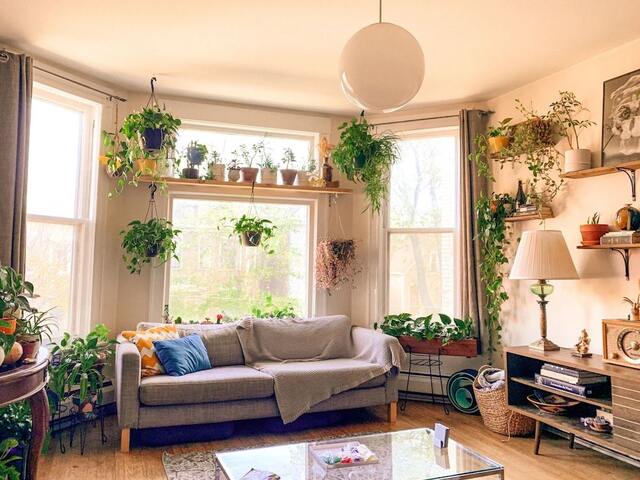
Furniture Selection
Choosing the right furniture is crucial in creating a boho living room. Focus on comfort and uniqueness. A boho sofa should be plush and inviting, encouraging relaxation. Look for pieces with unique designs, such as a vintage velvet couch or a rattan armchair. Mixing different styles is encouraged; for instance, a mid-century modern coffee table can work beautifully with a rustic wooden sideboard. Vintage finds add character, so don’t shy away from flea markets and thrift stores. The goal is to assemble a collection of furniture that feels curated and personal.
Color Palette
The color palette in a boho living room is both vibrant and earthy. Start with a base of warm, neutral tones like terracotta, beige, and brown. These colors create a soothing backdrop that allows more vibrant hues to stand out. Add pops of color through accessories and textiles. Jewel tones such as emerald green, sapphire blue, and ruby red are popular choices. These rich colors bring energy and sophistication to the room. When using multiple colors, ensure they complement each other to maintain harmony in the space.
Textures and Patterns
Textures and patterns are at the heart of boho design. Layering different textures creates a cozy and inviting atmosphere. Use a variety of textiles, such as cotton, linen, velvet, and macramé, in your cushions, throws, and curtains. Rugs are particularly important in boho decor; consider layering a patterned kilim rug over a larger jute rug for added depth. Patterns should be bold and varied, from geometric designs to floral prints. Combining these elements thoughtfully adds complexity and interest to the room without overwhelming it.
Lighting
Lighting plays a significant role in setting the mood in a boho living room. Aim for warm, ambient lighting that creates a cozy and inviting atmosphere. String lights, fairy lights, and lanterns are perfect for adding a soft glow. Statement lighting fixtures, such as Moroccan lanterns or vintage chandeliers, can serve as focal points. Candles also contribute to the warm and relaxed vibe. The key is to use a mix of lighting sources to create layers of light that enhance the room’s textures and colors.
Accessories
Accessories are what bring a boho living room to life. Plants are a must-have; they add greenery and a sense of calm. Use a variety of potted plants and hanging planters to create a lush, indoor garden. Decorative items should reflect your personal style and experiences. Look for unique pieces like vintage mirrors, tribal masks, and handmade pottery. These items add character and make the space feel lived-in. Don’t be afraid to mix and match different styles and eras; the eclectic nature of boho decor allows for a high degree of personalization.
Essential Boho Living Room Components
| Component | Description | Examples |
|---|---|---|
| Sofa | Comfortable, plush seating with a relaxed vibe | Vintage Sofa, Velvet Couch |
| Chairs | Unique designs, vintage flair | Rattan Chair, Wicker Armchair |
| Coffee Table | Wooden or rattan tables with intricate details | Distressed Wooden Table, Boho Coffee Table |
| Side Tables | Eclectic, intricate designs | Moroccan Side Table, Vintage Nightstand |
| Storage | Open shelving, vintage cabinets | Wooden Bookshelves, Antique Chest |
| Rugs | Layered, textured, and patterned | Kilim Rug, Moroccan Rug |
| Lighting | Warm, soft lighting, unique fixtures | Fairy Lights, Moroccan Lanterns |
| Wall Art | Eclectic mix of artwork | Woven Wall Hangings, Abstract Paintings |
| Plants | Abundant greenery | Potted Plants, Hanging Planters |
| Decorative Items | Eclectic, personal decor | Vintage Mirrors, Tribal Masks |
Table of Essential Boho Living Room Components
Key Elements of Boho Living Room Design
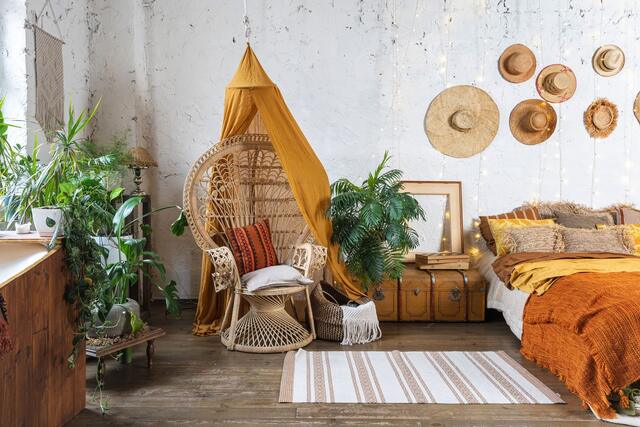
- Boho decor: This refers to the overall aesthetic and decorative elements used in bohemian design, including furniture, textiles, and accessories. It emphasizes a free-spirited, eclectic mix of styles and influences.
- Eclectic living room: A design approach that combines elements from various styles and periods, creating a unique and personalized space. It involves mixing modern and vintage pieces, different patterns, and textures.
- Bohemian furniture: Furniture pieces that fit the boho style, often vintage or handmade, with a focus on comfort and unique design. These pieces add character and a relaxed feel to the room.
- Layered textiles: The use of multiple layers of different fabrics and textures, such as rugs, cushions, and throws, to add depth and warmth. Layering creates a rich, tactile experience.
- Vintage finds: Incorporating vintage items and furniture into the decor, adding character and history to the space. These pieces often have unique designs and craftsmanship.
- Handmade decor: Items that are handcrafted, often featuring unique and artistic designs, contributing to the personalized feel of the room. Handmade items add a touch of artistry and individuality.
- Natural elements: Using materials like wood, rattan, and plants to bring an organic and earthy feel to the space. These elements connect the interior with nature, adding warmth and life.
- Bold patterns: Incorporating vibrant and intricate patterns through textiles and decor items, adding visual interest and energy. Patterns are a key component of boho style, creating a dynamic look.
- Jewel tones: Rich, vibrant colors like emerald green, sapphire blue, and ruby red, used as accent colors in boho decor. These colors add depth and sophistication to the space.
- Artistic touches: Adding artistic elements, such as paintings, sculptures, and wall hangings, to express creativity and individuality. Art enhances the personal and eclectic nature of boho interiors.
Tips for Achieving a Cohesive Look
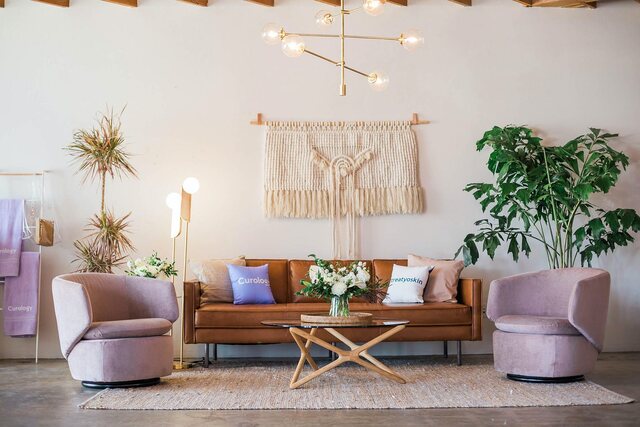
Balance Bold and Neutral
While boho style embraces bold colors and patterns, balancing them with neutral tones is crucial for creating a harmonious look. Start with a base of warm neutrals like beige, tan, and soft white to ground the space. Then, layer in bold hues and patterns through accessories, textiles, and artwork. This approach ensures that the room feels vibrant and lively without becoming overwhelming. The neutral tones provide a calming backdrop that allows the more colorful elements to shine.
Mix Old and New
One of the charms of boho style is its ability to blend old and new elements seamlessly. Combining vintage finds with modern pieces prevents the space from feeling overly dated or cluttered. For example, pair a contemporary sofa with a vintage coffee table, or modern art with an antique sideboard. This mix adds depth and interest to the room, creating a lived-in, curated feel. It also allows you to incorporate sentimental pieces alongside newer acquisitions, making the space truly personal.
Layering is Key
Layering is a fundamental principle in boho design. It involves combining different textures, patterns, and materials to create a rich, inviting space. Start with larger pieces like rugs and furniture, then add layers of cushions, throws, and smaller decor items. Each layer should introduce a new texture or pattern, contributing to the overall complexity of the room. This approach not only enhances visual interest but also creates a cozy, comfortable environment that invites relaxation.
100+ Boho Living Room Ideas and Inspirations: How to Perfectly Decorate in Bohemian Style?
Personalize Your Space
Boho design is all about individuality and self-expression. Personalize your living room by incorporating items that reflect your personality and experiences. Display travel souvenirs, family photos, and handmade crafts. Use books, artwork, and decorative items that have special meaning to you. These personal touches make the space feel unique and meaningful, transforming it from a styled room into a true reflection of your life and interests. Embrace the eclectic nature of boho design to showcase your creativity and personal story.
Conclusion
Creating a boho living room is about embracing creativity, individuality, and a relaxed, eclectic vibe. By incorporating vibrant colors, bold patterns, and a mix of textures and materials, you can transform your living room into a warm and inviting space. Use this guide to help you select the right furniture, decor, and accessories, and don’t be afraid to express your unique style. Embrace the beauty of boho design to create a living room that is not only stylish but also deeply personal and comforting.
For more Informative articles you can visit our blog royalsprinter.com

